World Food: Mexico CityHERITAGE RECIPES FOR CLASSIC HOME COOKING [A MEXICAN COOKBOOK]
Introducing World Food, an exceptional new cookbook series in the classic tradition, taking readers on a journey to the world’s greatest cuisines and the remarkable cultures they come from.
NAMED ONE OF THE BEST COOKBOOKS OF THE YEAR BY THE ATLANTA JOURNAL-CONSTITUTION AND TOWN & COUNTRY
Whether you’re an absolute beginner at Mexican cooking or already a pro, World Food: Mexico City is for you. This definitive and beautiful user’s guide unlocks the secrets to real Mexican cuisine with more than fifty authentic, reliable recipes, while the compelling stories and photography tell the tale of the vibrant culinary capital of Latin America. You’ll be taken to home kitchens, markets, and restaurants, where you’ll get to know exemplary local cooks and learn how to master Mexican culinary traditions and techniques.
Every recipe—from the vivid salsa with pan-roasted tomatoes to the soul-satisfying pork stew with corn, potatoes, and green beans—provides a cook’s-eye lens into real Mexico City culture. Explore easy party food such as authentic guacamole and homemade tortilla chips; satisfying first courses such as cantina-style garlic soup and beer-infused “drunken” rice; or slow-cooked masterpieces such as Mexican-style stewed zucchini. Learn how to make family-friendly meals including ancho chiles stuffed with cheese, as well as standouts such as fall-apart tender roasted lamb with pasilla chiles, or tuna tostada garnished with chipotle mayonnaise and avocado—a modern classic from the beloved restaurant Contramar.
With more than 150 photographs and a comprehensive illustrated reference chapter that tells you how to find, use, and store all the necessary ingredients, from cilantro to Mexican cheeses, World Food: Mexico City satisfies an appetite for new recipes, new ways to cook, and a new way of understanding one of the most exciting food destinations on the planet
James Oseland travels extensively in search of the world’s best restaurants, street food stalls, markets, and home cooks. He has been writing about international cultures and their cuisines for decades and was editor in chief of Saveur for eight years, where his work garnered many accolades, including from the James Beard Foundation, the International Association of Culinary Professionals, and the American Society of Magazine Editors. His cookbook Cradle of Flavor was named one of the best books of the year by the New York Times and Good Morning America. He was also a judge for five years on Bravo’s Top Chef Masters.
James Oseland
So you find yourself in Mexico City, the world’s 5th most populated city. and you’re famished. Where do you go to eat? How to begin to understand the metropolis. How do you find a truly unique and interesting place to go? James Oseland has had a long term love affair with Mexico city. His book, the first of the new World Food Series, is a culinary field guide of sorts to entrenching, and enriching oneself within the storied place.
James Oseleland recently talked with us about his book and the city he loves.
BAF: Maybe I could start by asking a little about the World Food series?
James Oseland: World Food is a new ongoing book series that endeavors to document and capture the contemporary food cultures of the world’s greatest eating destinations and oldest cuisines, oldest and most important cuisines. The first book in the series World Food: Mexico City, focuses on a place near and dear to me, because it was the first foreign city I ever knew.
The next book in the series focuses on the cuisine of Paris. Future books will deal with countries and culinary regions. It’s not a book series about cities. It’s a book series about important food places, and they come out every year in the fall, a new one.
BAF: Am I allowed to ask what’s next after Paris?
James Oseland: I’m figuring that out right now. We’ll begin producing the book in 2021, but truthfully, the next destination is contingent on where we can travel to at that time. There is a strong likelihood that it will be somewhere in Asia, I hope.
BAF: How do you ‘discover’ Mexico City? It’s a huge city.
James Oseland: I first came to Mexico city in 1980 as a 17 year old with my father on a road trip all the way from Louisiana where he then lived. I’d been a little bit in Canada as a younger person growing up. That trip that we took then was the first real foreign trip of my entire life. When we arrived in the center of the city where we were staying, and I got my first look at the Cathedral of Mexico City and the grand plaza known as the Zocalo, it’s one of the largest public spaces in the world, it changed, that experience changed my life. Mexico City has been, ever since that time, an active part of my life, a place that I travel to as frequently as possible. I’ve been here over 40 times before. Working on World Food: Mexico City reminded me of what a grand and livable place it is. I made the decision to move here then.
BAF: How do you go about compressing a city as large and as vibrant and diverse as Mexico City, into a book?
James Oseland: The World Food series focuses on traditional cooking methods and classic dishes, primarily. The series, generally speaking, is drawn to the interpretations of classic cooking that happen in a home kitchen, not necessarily in restaurants or on the street or coming from the world of fine dining. Instead the series takes a look at the core cuisine of a place and how that cuisine represents what the particular cuisine that we’re focusing on.
When I came to Mexico City, roughly four years ago to begin producing the book, I did my level best to put aside any preconceived notions I had about the place, because Mexico City is a place that I know very well. I ‘turned the page’ and started a process of finding dedicated, local cooks, largely, as I was just mentioning, home cooks, who were especially dedicated to the importance of traditional Mexican cooking and the beauty of home cooking and it’s expression of both history and family heritage. Over the course of many months, I was lucky enough to find roughly 40 cooks all around the city from wildly different backgrounds and who it turned out also had, most of the time, heritage in other parts of Mexico, family heritage, lineage, and roots in other parts of Mexico. With these people, Ibegan to experience the wonder that is the wonder of the great variety of food that is eaten in Mexico City. A city of 23 million residents, more or less.
James Oseland: I love Mexico City. It’s always been a place I’ve enjoyed being.
BAF: Mexican food, I’m going to play devil’s advocate here for a second, has kind of a, almost a stale/unappreciated reputation here in the US. How do you go about dispelling that myth, or is that one of the goals in the book to dispel these preconceptions?
James Oseland: That’s one of the easiest things possible, because Mexican food is glorious and rich and complicated and has a history that is thousands of years old. Interpretations of it that we might be largely familiar with in the United States are the tip of the tip of the tip of the iceberg. When one really begins to know and understand Mexican food and how complicated, or sorry, completely wrong word, how rich and delicious it is, it immediately becomes clear that it is a collection of cuisines on par with those of France or China in terms of global culinary importance.
One of the things that I really wanted to capture in the book was, yes, a cook in the United States can make Mexican dishes using Mexican ingredients and Mexican techniques. The goal of the book, and for me, what is really, really thrilling as an editor and a writer, is the ability to convey to the reader and the cook, ability to understand key components of Mexican flavor, the real authentic flavor of Mexican food and the techniques that create that flavor. The lion’s share of the dishes in the book that represent that, I think best, the recipes in the book that represent that best, are ones that are in fact very simple to make and aren’t baroque creations like a mole or a chile nogada, the classic dish of poblano chilies stuffed with fruit and meat. Instead, are dishes like a perfectly stewed pot of beans cooked in the Mexican style, served with a dab of fresh made charred tomato salsa, another Mexican classic.
Americans don’t necessarily think of eating their beans with salsa, but that’s how Mexicans do it. When one does that one’s self, and mixes that salsa in and tastes the way it changes the flavor of the beans and the experience of eating them, I think one is on the road to understanding the cuisines of Mexico.
BAF: How did you go about finding these home cooks to teach you all these things?
James Oseland:Through friends, and friends of friends, and people I met in markets, or people I met out and about. This is fundamentally the work that I’ve been doing for the last 35 years of my life. I have a radar, I suppose, that generally speaking, knock on wood, leads me in the direction of wonderful cooks.
BAF: Good skill to have.
James Oseland: It’s a fun skill to have. When I started work on the book, I didn’t have an idea of how I wanted it to go and who I wanted to find. Instead, I remained open to what came about naturally. Then, over the months realized, wow, what a lucky set of circumstances I fell into that introduced me to people who not only shared recipes with me, but ultimately became friends.
BAF: That’s the beauty of cooking.
James Oseland: Yeah. Because cooking and recipes…tend to be a place where we really come together and share in the most happy, fun way as human beings. The exchange of recipes, in my experience, is almost always a cause for celebration, not ownership.
BAF: How would you advise somebody who was going to go to Mexico for the first time, to approach the city?
James Oseland: I would hope that someone approaching Mexico city for the first time would have the advantage to experience it in a way that I did that first time in 1980, which was without agenda and open. I think that a lot of modern travelers’ days have too much dependence on research that they’ve done on the internet. They don’t allow themselves the magic of travel, which is to say more specifically the magic of the unknown and not knowing exactly where you’re going to be eating dinner or lunch, but instead really paying attention to the signs and signals and desires that are all right there all around you. My main advice is put aside the Yelp research and just allow yourself to be there. You’ll find the right place to eat or the right place to go. It may not be the experience to end all experiences, but it’ll be authentic to your moment and your understanding of that place. Nothing can replace that.
BAF: Can I ask about the book’s photographer?
James Oseland: The photographer is named James Roper.
James is a photographer based in Kansas who is infinitely talented, I believe. He shot for Saveur for a number of years. He has a sensitivity to be able to go into these very intimate environments, the environments of home kitchens and allow people to be so comfortable with his presence that he can capture this very delicate, personal moment cooking in one’s own home kitchen. He has a remarkable knack, a skill at being able to do that. I don’t know what’s behind that skill, but he, and I could never pretend to. He has what I’ve observed to be just almost an ability to be both invisible and present at the same time. Also, interested enough fundamentally in the cooking that is going on in the kitchen, because he himself is a cook. It’s just a kind of quiet, fun magic that comes together. It’s something to be seen.
BAF: You seem to be uncovering some great ‘secrets’ about Mexico City, or maybe they’re not even secrets. Maybe they’re just there, but have been overlooked by people over here.
James Oseland: I think that’s a better way to word it. I mean, Mexico City is a marvelously open place, but I do think that there’s been a tendency in covering its culinary culture in the United States, in US media, where it’s a bit formulaic. There’s almost an expectation that Mexico City tastes and looks like this, when in fact, there’s so much more to the story than what is usually portrayed. The idea with World Food: Mexico City is that we are truly capturing the true vibrant culinary essence of Mexico City and its traditional cuisine is captured in a way, unlike other usual presentations of Mexico City and its cuisine.
BAF: Was there anything that really took you by surprise even after living there for four years?
James Oseland: Yes, in many ways, and every day I learn new things. I think that I had always had the expectation that classic Mexican dishes were demanding to prepare at home alone. What I grew to understand over time dishes like a mole or a complicated roast, but what I grew to understand over time was that classic Mexican home cooking is pretty straightforward. Oftentimes, it doesn’t involve much more than dried chilies, garlic, onions, a protein, and a vegetable to make a stew known as a guisado, G-U-I-S-A-D-O, which is the foundation of the Mexican table. A homey basic stew full of flavors that immediately evoke Mexico and also are very ancient dishes that have roots reaching back thousands of years.
BAF:Oh, I’m really getting hungry now.
James Oseland: That’s good. That’s good.
BAF: What’s next for you? Another book in the series, a continuation, or are there other projects?
James Oseland: There are, and I’m figuring them out. I see World Food as the beginning of a new way to approach and a new way to shine the spotlight on traditional cuisine around the world and developing ideas, maybe even ones that’s a television idea that would best express this mission. One of the things that I’m interested in having a look at with the entire series and the brand, if you will, although that’s not one of my favorite words, it is useful.
One of the really tremendous things that has become clear to me in not only working on the two books that I’ve already worked on in the series, but also earlier work that I’ve done in my life at Sever with Cradle of Flavor, my first book, which is about Indonesia, the cuisine of Indonesia, is that there is this surprising and truly beautiful connectivity between the world’s cuisines that not only involves crossover ingredients and techniques, but shows us how much the world’s cuisines have in common rather than how different they are and how separate they are. That, for me, is a genuinely exciting thing.
~~~~~~~~~
Booksaboutfood.com©2020
Milanesa-Style Beef Burgers (Milanesas de Carne Molida)
Spicy Habanero Guacamole (Guacamole con Chile Habanero)
![]()
Milanesa-Style Beef Burgers (Milanesas de Carne Molida)
 A comida (lunchtime) favorite, this is a very thin beef patty that has been breaded and panfried until golden and a little crisp. It’s a secret weapon of busy cooks who want to provide something quick and substantial. Serve with warm tortillas and your favorite salsa.
A comida (lunchtime) favorite, this is a very thin beef patty that has been breaded and panfried until golden and a little crisp. It’s a secret weapon of busy cooks who want to provide something quick and substantial. Serve with warm tortillas and your favorite salsa.
Makes 8 patties
1 pound ground beef
1 egg, lightly beaten
2 tablespoons coarsely chopped fresh flat-leaf parsley leaves
3⁄4 cup fine dried bread crumbs
Salt and freshly ground black pepper
Canola oil, for frying
1. In a medium bowl, combine the beef, egg, parsley, 1⁄4 cup of the bread crumbs, 1⁄4 teaspoon salt, and a few grinds of pepper and mix until all the ingredients are evenly distributed. Spread the remaining 1⁄2 cup bread crumbs on a plate, sprinkle with 1⁄4 teaspoon salt and a couple of grinds of pepper, and mix together.
2. Scoop up 3 tablespoons at a time of the meat mixture and form into very thin, round patties about 3 inches in diameter and 1⁄4 inch thick. Press each side of the patties into the seasoned bread crumbs, creating a crust on both sides. Set the patties aside. You should have 8 patties total.
3. Line a platter with paper towels. Heat a 12-inch skillet over medium heat. When the pan is hot, add about 11⁄2 tablespoons of the oil. When the oil is hot, working in batches and adding more oil to the pan as needed, add as many patties as will comfortably fit in the pan and fry, turning once, until a delicate golden brown on both sides, about 2 minutes on each side. As they are ready, transfer them to the platter. Serve at once.
![]()
Spicy Habanero Guacamole (Guacamole con Chile Habanero)
Guacamole has near-universal appeal and is exceedingly easy to make. Any fresh, small chile can be substituted for the habanero (if extra heat is desired, leave in the seeds). Mash the ingredients with a fork, a potato masher, or with your hands. Serve with homemade totopos (tortilla chips).
Makes 11⁄2 cups
2 ripe medium avocados, halved, pitted, and peeled
1⁄4 medium white onion, minced
1 habanero chile, seeded and minced
1⁄2 cup loosely packed fresh cilantro leaves, minced
1 to 11⁄2 tablespoons freshly squeezed lime juice, depending on desired tartness
Salt
Tortilla chips, for serving
In a bowl, combine the avocados, onion, chile, cilantro, 1 tablespoon of the lime juice, and 1⁄2 teaspoon salt. Mix and mash the ingredients until you have a coarse, chunky-smooth consistency. Taste and add more lime juice and salt if needed. Serve at once with the tortilla chips.
“Reprinted with permission from World Food: Mexico City: Heritage Recipes for Classic Home Cooking by James Oseland, copyright © 2020. Published by Ten Speed Press, an imprint of Penguin Random House.”
Photography copyright: James Roper © 2020 except:


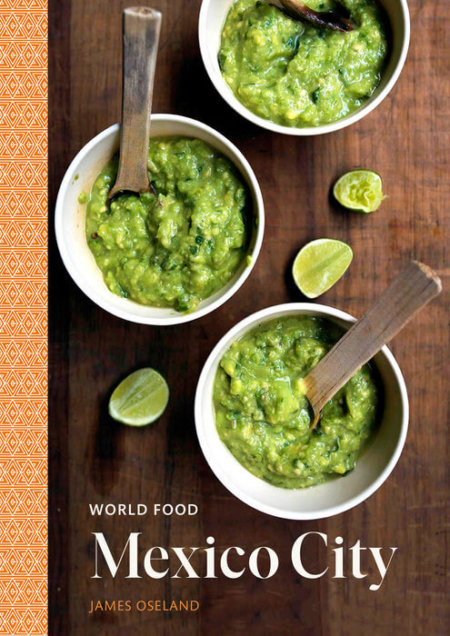


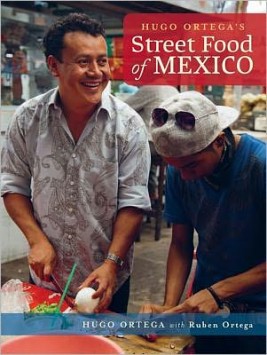
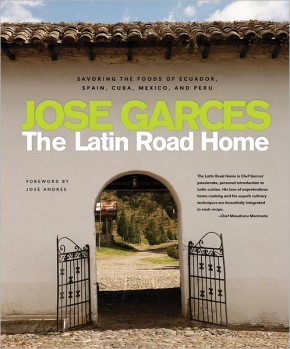
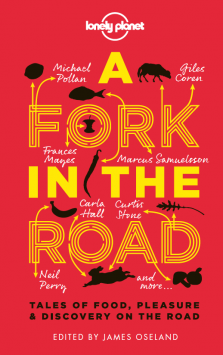
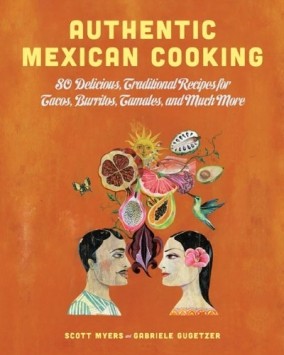
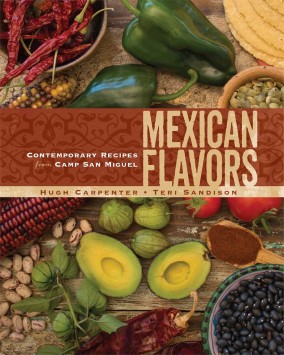

Leave a Reply